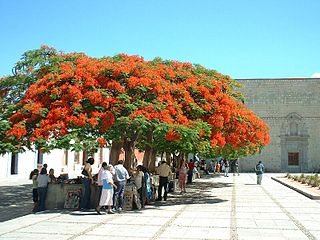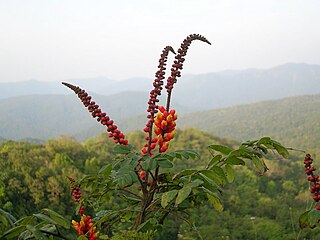
Caesalpinioideae is a botanical name at the rank of subfamily, placed in the large family Fabaceae or Leguminosae. Its name is formed from the generic name Caesalpinia. It is known also as the peacock flower subfamily. The Caesalpinioideae are mainly trees distributed in the moist tropics, but include such temperate species as the honeylocust and Kentucky coffeetree. It has the following clade-based definition:
The most inclusive crown clade containing Arcoa gonavensisUrb. and Mimosa pudicaL., but not Bobgunnia fistuloides(Harms) J. H. Kirkbr. & Wiersema, Duparquetia orchidaceaBaill., or Poeppigia proceraC.Presl

Libidibia ferrea, formerly Caesalpinia ferrea, and commonly known as Brazilian ironwood, leopardtree or jucá, is a tree found in Brazil.
Stuhlmannia moavi is a species of flowering plants in the legume family, Fabaceae. It is the only species in the genus Stuhlmannia. It is a tree native to Kenya, Tanzania, and Madagascar, where it grows in seasonally-dry tropical forest, woodland on limestone, and in riverine forest. The genus belongs to tribe Caesalpinieae in subfamily Caesalpinioideae.

Machaerium is a genus of flowering plants in the family Fabaceae, and was recently assigned to the informal monophyletic Dalbergia clade of the Dalbergieae. It contains the following species:

Hoffmannseggia is a genus of flowering plants in the pea family, Fabaceae, known generally as rushpeas. These are pod-bearing herbs and subshrubs native to the Americas. In North America they range from California and Nebraska to southern Mexico, and from Colombia, Ecuador, and Peru to southern Argentina and Chile in South America. The generic name honors Johann Centurius, Count of Hoffmannsegg, a nineteenth-century German nobleman and botanist.

Moullava is a genus of flowering plants in the legume family, Fabaceae. It includes four species of lianas or scrambling shrubs native to tropical Africa from Cameroon to Tanzania and Angola, and to tropical Asia from India to Indochina, southern China, and western Malesia. Typical habitat includes forest margins of seasonally-dry semi-evergreen tropical forest. It belongs to the subfamily Caesalpinioideae.
Pomaria is a genus of flowering plants in the legume family, Fabaceae. It includes 16 species of shrubs and perennial herbs native to North America, South America, and southern Africa. Typical habitats include drier subtropical grasslands and wooded grasslands, often on limestone, and degraded areas. It belongs to tribe Caesalpinieae of subfamily Caesalpinioideae.

The tribe Dalbergieae is an early-branching clade within the flowering plant subfamily Faboideae. Within that subfamily, it belongs to an unranked clade called the dalbergioids. It was recently revised to include many genera formerly placed in tribes Adesmieae and Aeschynomeneae and to be included in a monophyletic group informally known as the dalbergioids sensu lato. The members of this tribe have a distinctive root nodule morphology, often referred to as an "aeschynomenoid" or "dalbergioid" nodule.

Hultholia mimosoides is a liana species and the sole species in the genus Hultholia. It was formerly placed in the genus Caesalpinia but phylogenetic studies identified the group to be polyphyletic, leading the placement of Caesalpinia mimosoides in a new genus, Hultholia in the tribe Caesalpinieae. Its distribution includes: Bangladesh, Yunnan in China, India, Laos, Myanmar, Thailand, and Vietnam.

The tribe Caesalpinieae is one of the subdivisions of the plant family Fabaceae: subfamily Caesalpinioideae.
Erythrostemon is a genus of flowering plants in the legume family, Fabaceae. Its native range is tropical & subtropical America.

Mezoneuron is a genus of flowering plants in the legume family, Fabaceae. It belongs to the subfamily Caesalpinioideae and the tribe Caesalpinieae.

Arquita is a genus of flowering plants in the family Fabaceae. It belongs to the subfamily Caesalpinioideae. It includes five species, which range from Ecuador to northern Argentina.
Biancaea is a genus of flowering plants in the family Fabaceae. It includes seven species, which range from Yemen to south Asia, Indochina, Malesia, China, Korea, and Japan. It belongs to the subfamily Caesalpinioideae and the tribe Caesalpinieae.
Denisophytum is a genus of flowering plants in the family Fabaceae. It belongs to subfamily Caesalpinioideae and tribe Caesalpinieae. It includes eight species, which have a disjunct distribution – northern Mexico, Florida and the Caribbean, southern South America, the Horn of Africa, the Arabian Peninsula, and Madagascar.

Gelrebia is a genus of flowering plants in the family Fabaceae. It belongs to the subfamily Caesalpinioideae. It includes eight species native to sub-Saharan Africa, which range from Ethiopia to the Democratic Republic of the Congo and South Africa.

Libidibia is a genus of flowering plants in the family Fabaceae. It includes seven species of trees and shrubs native to the tropical Americas, ranging from northern Mexico to northern Argentina. Typical habitats include seasonally-dry tropical forest and scrub, thorn forest, and savanna woodland. It belongs to the subfamily Caesalpinioideae.
Mezoneuron hymenocarpum is a species of 'cat's claw' lianas, previously placed in the genus Caesalpinia, in the tribe Caesalpinieae. Records are from: India, Indo-China, Malesia through to Australia, with no subspecies.











